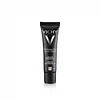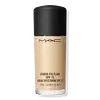Vichy Dermablend 3d Correction Foundation Versus Mac Cosmetics Studio Fix Fluid Foundation With SPF 15
What's inside
What's inside
 Key Ingredients
Key Ingredients

 Benefits
Benefits

 Concerns
Concerns

 Ingredients Side-by-side
Ingredients Side-by-side

Water
Skin ConditioningDimethicone
EmollientGlycerin
HumectantSynthetic Fluorphlogopite
Hydroxyethyl Acrylate/Sodium Acryloyldimethyl Taurate Copolymer
Emulsion StabilisingDimethicone Crosspolymer
Emulsion StabilisingTriethanolamine
BufferingSalicylic Acid
MaskingAluminum Hydroxide
EmollientPhenoxyethanol
PreservativeDisodium Stearoyl Glutamate
CleansingEperua Falcata Bark Extract
Skin ProtectingTitanium Dioxide
Cosmetic ColorantCI 77491
Cosmetic ColorantCI 77492
Cosmetic ColorantCI 77499
Cosmetic ColorantWater, Dimethicone, Glycerin, Synthetic Fluorphlogopite, Hydroxyethyl Acrylate/Sodium Acryloyldimethyl Taurate Copolymer, Dimethicone Crosspolymer, Triethanolamine, Salicylic Acid, Aluminum Hydroxide, Phenoxyethanol, Disodium Stearoyl Glutamate, Eperua Falcata Bark Extract, Titanium Dioxide, CI 77491, CI 77492, CI 77499
Ethylhexyl Methoxycinnamate 2.5%
UV AbsorberTitanium Dioxide 1%
Cosmetic ColorantWater
Skin ConditioningCyclopentasiloxane
EmollientPEG-10 Dimethicone
Skin ConditioningButylene Glycol
HumectantTrimethylsiloxysilicate
EmollientDimethicone
EmollientMagnesium Sulfate
Laminaria Saccharina Extract
Skin ProtectingAlgae Extract
EmollientTocopheryl Acetate
AntioxidantSodium Hyaluronate
HumectantTocopherol
AntioxidantLecithin
EmollientHydrogenated Lecithin
EmulsifyingXanthan Gum
EmulsifyingSorbitan Sesquioleate
EmulsifyingMethoxy Amodimethicone/Silsesquioxane Copolymer
Skin ConditioningLaureth-7
EmulsifyingDipropylene Glycol
HumectantDimethicone/PEG-10/15 Crosspolymer
Dimethicone/PEG-10 Crosspolymer
EmollientPEG/PPG-18/18 Dimethicone
EmulsifyingDisteardimonium Hectorite
StabilisingSilica
AbrasiveDimethicone Crosspolymer
Emulsion StabilisingTriethoxycaprylylsilane
Propylene Carbonate
SolventPentaerythrityl Tetra-Di-T-Butyl Hydroxyhydrocinnamate
AntioxidantSorbic Acid
PreservativeChloroxylenol
AntimicrobialPhenoxyethanol
PreservativeCI 77891
Cosmetic ColorantIron Oxides
CI 77288
Cosmetic ColorantEthylhexyl Methoxycinnamate 2.5%, Titanium Dioxide 1%, Water, Cyclopentasiloxane, PEG-10 Dimethicone, Butylene Glycol, Trimethylsiloxysilicate, Dimethicone, Magnesium Sulfate, Laminaria Saccharina Extract, Algae Extract, Tocopheryl Acetate, Sodium Hyaluronate, Tocopherol, Lecithin, Hydrogenated Lecithin, Xanthan Gum, Sorbitan Sesquioleate, Methoxy Amodimethicone/Silsesquioxane Copolymer, Laureth-7, Dipropylene Glycol, Dimethicone/PEG-10/15 Crosspolymer, Dimethicone/PEG-10 Crosspolymer, PEG/PPG-18/18 Dimethicone, Disteardimonium Hectorite, Silica, Dimethicone Crosspolymer, Triethoxycaprylylsilane, Propylene Carbonate, Pentaerythrityl Tetra-Di-T-Butyl Hydroxyhydrocinnamate, Sorbic Acid, Chloroxylenol, Phenoxyethanol, CI 77891, Iron Oxides, CI 77288
 Reviews
Reviews

Ingredients Explained
These ingredients are found in both products.
Ingredients higher up in an ingredient list are typically present in a larger amount.
Dimethicone is a type of synthetic silicone created from natural materials such as quartz.
What it does:
Dimethicone comes in different viscosities:
Depending on the viscosity, dimethicone has different properties.
Ingredients lists don't always show which type is used, so we recommend reaching out to the brand if you have questions about the viscosity.
This ingredient is unlikely to cause irritation because it does not get absorbed into skin. However, people with silicone allergies should be careful about using this ingredient.
Note: Dimethicone may contribute to pilling. This is because it is not oil or water soluble, so pilling may occur when layered with products. When mixed with heavy oils in a formula, the outcome is also quite greasy.
Learn more about DimethiconeDimethicone Crosspolymer is a silicone created by modifying dimethicone with hydrocarbon side chains. Due to its large size, it does not penetrate skin. It is considered non-occlusive.
Dimethicone Crosspolymer is used to stabilize and thicken products. It also helps give products a silky feel.
Phenoxyethanol is a preservative that has germicide, antimicrobial, and aromatic properties. Studies show that phenoxyethanol can prevent microbial growth. By itself, it has a scent that is similar to that of a rose.
It's often used in formulations along with Caprylyl Glycol to preserve the shelf life of products.
Titanium dioxide is a mineral UV filter widely used in sunscreens and cosmetics.
It is one of only two UV filters officially classified as “mineral” by regulatory agencies, the other being zinc oxide.
Titanium dioxide provides broad-spectrum protection mostly in the UVB and UVAII range, with some protection in the UVAI range.
While its UVA protection isn’t as strong as zinc oxide’s, the difference is minor.
A common myth is that mineral UV filters reflect UV light. However, modern research shows titanium dioxide absorbs UV radiation like chemical filters (~95% absorption & 5% reflection).
Thanks to its non-irritating nature, titanium dioxide is suitable for sensitive, acne-prone, or redness-prone skin. It is unlikely to cause "eye sting" like other sunscreen ingredients.
A major drawback of this ingredient is its white cast and thick texture. This is why mineral sunscreens often leave a white cast and are less cosmetically elegant than chemical/hybrid sunscreens.
To improve white cast and spreadability, micronized or nano-sized titanium dioxide is often used.
There are ongoing concerns surrounding nano-titanium oxide's impact on marine ecosystems.
There is no conclusive evidence that any form of titanium oxide (or any other sunscreen ingredients) will cause harm to marine ecosystems or coral reefs. The science is still developing but many consumers are keeping a close eye on this issue.
Please note, many destinations have reef-safety sunscreen rules. For instance, the U.S. Virgin Islands advises all visitors to use non-nano mineral sunscreens.
Nano mineral sunscreens once raised safety concerns about absorption into skin.
Extensive research has shown that they do not penetrate healthy or damaged skin; they remain safely on the surface and the top layer of dead skin (stratum corneum).
You'll likely find titanium dioxide bundled with alumina, silica, or dimethicone. These ingredients help make titanium dioxide highly photostable; this prevents it from interacting with other formula components under UV light.
Learn more about Titanium DioxideWater. It's the most common cosmetic ingredient of all. You'll usually see it at the top of ingredient lists, meaning that it makes up the largest part of the product.
So why is it so popular? Water most often acts as a solvent - this means that it helps dissolve other ingredients into the formulation.
You'll also recognize water as that liquid we all need to stay alive. If you see this, drink a glass of water. Stay hydrated!
Learn more about Water